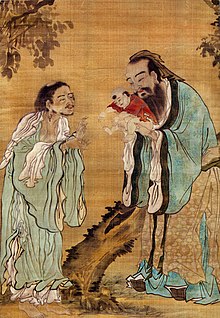User:Wound theology/Taoism
| Taoism | |||||||||||||||||||||||||||||||||||||||||||
|---|---|---|---|---|---|---|---|---|---|---|---|---|---|---|---|---|---|---|---|---|---|---|---|---|---|---|---|---|---|---|---|---|---|---|---|---|---|---|---|---|---|---|---|
 The Chinese character for the Tao, often translated as 'way', 'path', 'technique', or 'doctrine' | |||||||||||||||||||||||||||||||||||||||||||
| Chinese name | |||||||||||||||||||||||||||||||||||||||||||
| Chinese | 道教 | ||||||||||||||||||||||||||||||||||||||||||
| Hanyu Pinyin | Dàojiào | ||||||||||||||||||||||||||||||||||||||||||
| Literal meaning | "Religion of the Way" | ||||||||||||||||||||||||||||||||||||||||||
| |||||||||||||||||||||||||||||||||||||||||||
| Vietnamese name | |||||||||||||||||||||||||||||||||||||||||||
| Vietnamese alphabet | Đạo giáo | ||||||||||||||||||||||||||||||||||||||||||
| Chữ Hán | 道教 | ||||||||||||||||||||||||||||||||||||||||||
| Korean name | |||||||||||||||||||||||||||||||||||||||||||
| Hangul | 도교 | ||||||||||||||||||||||||||||||||||||||||||
| Hanja | 道敎 | ||||||||||||||||||||||||||||||||||||||||||
| |||||||||||||||||||||||||||||||||||||||||||
| Japanese name | |||||||||||||||||||||||||||||||||||||||||||
| Kanji | 道教 | ||||||||||||||||||||||||||||||||||||||||||
| Hiragana | どうきょう | ||||||||||||||||||||||||||||||||||||||||||
| |||||||||||||||||||||||||||||||||||||||||||
| Part of a series on |
| Taoism |
|---|
 |
Taoism, also Daoism (Chinese: dàojiào) is an East Asian religion native to China, traditionally attributed to the legendary sage Laozi.
Overview
[edit]Taoism is centrally concerned with the Tao, "a nameless, formless, all-pervasive power which brings all things into being and reverts them back into non-being in an eternal cycle."[1]
History
[edit]In the early Han dynasty, scholars retroactively attributed labeled classical writings with no clear historical connection as "Taoist."[2] The first self-identified Taoists appeared in the 5th century CE, stimulated by the introduction of Buddhism to China.[3]
Mythological origins
[edit]Taoism is traditionally attributed to the works of Lao Tzu and Chuang Tzu, two legendary figures of early China.
Sects and schools
[edit]Historiography
[edit]Western scholars have traditionally split Taoism into "religious Taoism" (道教; dàojiào) and "philosophical Taoism" (道家; dàojiā).[4][5] More recent scholars, such as Russell Kirkland, have considered "mystical models" in relation to "liturgical models", while Livia Kohn has proposed a tripartite typology of literati, communal, and self-cultivation Taoism.[6] These terms are foreign to Taoism itself.[7] Modern Taoists make a distinction between "Northern Taoism" and "Southern Taoism."[8]
Relationship to other religions
[edit]
Tang-era Taoists wrote extensively on "Tao-nature", which closely resembles "Buddha-nature" in East Asian Buddhism. Northern Taoism interacted intimately with Chan and late imperial Confucianism.[9]
See also
[edit]Schools and organizations
[edit]Concepts and objects
[edit]Practice
[edit]Deities
[edit]Texts
[edit]Regional Taoism
[edit]China
[edit]- Chinese culture
- Chinese gods and immortals
- Chinese ritual mastery traditions
- Chinese spiritual world concepts
- Taoism and Confucianism
- Taoism in Hong Kong
Japan
[edit]Southeast Asia
[edit]Europe
[edit]References
[edit]Citations
[edit]- ^ Oldstone-Moore 2003, p. 6.
- ^ Kirkland, Russell (2002). "The History of Taoism: A New Outline". Journal of Chinese Religions. 30 (1): 177–193. doi:10.1179/073776902804760257. ISSN 0737-769X.
- ^ Kirkland 2004, p. 16.
- ^ Oldstone-Moore 2003, p. 13.
- ^ Kirkland 2004, p. 2: "For one thing, most scholars who have seriously studied Taoism, both in Asia and in the West, have finally abandoned the simplistic dichotomy of tao-chia and tao-chiao -- 'philosophical Taoism' and 'religious Taoism.'"
- ^ Kirkland 2004, p. 2.
- ^ Kirkland 2004, p. 2: "It should be noted in this connection, however, that Taoists have never made any distinctions of such kinds, and it is such very facts that challenge our hermeutical imagination."
- ^ Kirkland 2004, p. 4.
- ^ Kirkland 2004, p. 5.
General sources
[edit]- Kirkland, Russell (2004). Taoism: The Enduring Tradition. New York, NY: Routledge. ISBN 0-415-26322-0.
- Oldstone-Moore, Jennifer (2003). Taoism: Origins, Beliefs, Practices, Holy Texts, Sacred Places. Oxford New York: Oxford University Press, USA. ISBN 978-0-19-521933-3.
External links
[edit]- BBC religions – Taoism
- Taoism on In Our Time at the BBC
- "Taoist philosophy". Internet Encyclopedia of Philosophy.
- Early Taoist texts – Chinese Text Project
- Patheos Library – Taoism
- Taoist Texts at the Internet Sacred Text Archive
- Collection: "Daoism/Taoism" from the University of Michigan Museum of Art
Category:Taoism
Category:Chinese astrology
Category:Chinese folk religion
Category:Classical Chinese philosophy
Category:Dualism in cosmology
Category:East Asian religions
Category:Three teachings

